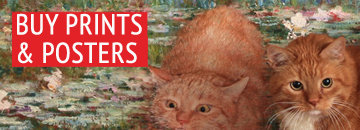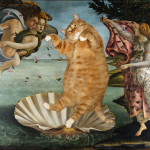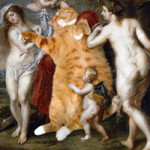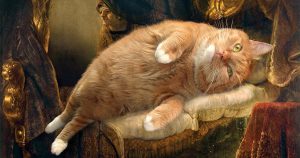What’s in a name? Portrait of Madeleine and David Bowie the Cat
Today We, Zarathustra the Cat, reveal the true version of the 1800’s enigmatic portrait of a black woman by the famous French female artist Marie-Guillemine Benoist, which appeared to also feature an odd-eyed white cat.

Portrait of Madeleine and David Bowie the Cat, aka Portrait of a black woman with a white cat,Louvre 1800
Once we suggested Our beloved brother David Bowie the Cat travel in time and become a model for a piece of art of his choice. DB was so stressed at that time, he was recently rescued from an abusive hoarder who collected beautiful stray cats from the streets in order to sell them expensively further. And DB was beautiful, We are thinking he is a purebred Angora of Van who was dumped in the street by a cruel breeder because the poor cat had genetic issues. Happily, DB was rescued by good humans, washed 7 times, got rid of his status of biological weapon that Our beloved vet awarded him, and, finally, peace and comfort entered into his life in his new forever home. And then the time for art came.
We traveled to France on the eve of the 19th century to see the work of Marie-Guillemine Benoist, a French painter with feminist ideas, who studied art at the studio of the famous Élisabeth Vigée Le Brun and then entered Jacques-Louis David’s atelier.
In 1800, Benoist exhibited a rather unusual for its time painting under the title “Portrait d’une négresse” in the Salon of Paris. Six years previously, slavery had been abolished in French colonies (in the mainland slavery had been forbidden since the Middle Ages), and this image became a symbol of women’s emancipation and black people’s rights because it presents a black person as the sole aestheticized subject and object of a work of art.
The model is painted not within the weak stereotype of a black woman of that time. The striking similarity in classical pose and costume to Benoist’s own self-portrait, painted in 1786 proves that she depicted her black counterpart as a mental and rational equal.

Marie-Guillemine Benoist, Self-portrait Copying David’s Belisarius, 1786 (Staatliche Kunsthalle Karlsruhe)
You would say, but still no equality because the artist’s breast is slightly, but covered, and the model’s breast is not!
But We should remind you that a bared breast was a motif frequently used in classic paintings’ allegories. Just remember the commonly known version of Eugène Delacroix’s Liberty Leading the People and note that the woman in the Benoist’s painting wears a white gown with a red waistband and her blue shawl is thrown on her chair’s back, therefore, her costume included the blue, white, and red colors of the tricolor flag that had been adopted by the French Revolutionary Government in 1789. So, the painting represented a kind of allegory of freedom and emancipation.
But who was the sitter who became a subject of such a beautiful and meaningful painting, you would ask? Recent research has provided the sitter’s first name, Madeleine. Madeleine is thought to have been brought to France from the island of Guadeloupe by the artist’s brother-in-law. She was likely born a slave in the colony and freed by the decree of 1794, and then she worked in his house in France as a servant.
Why the portrait was not entitled with her name at its first exhibition in the salon? It was quite usual to protect sitters’ privacy by using titles such as “Portrait of a Lady” or “Portrait of a Peasant” when exhibiting works at the Salon. Many paintings’ titles derive from the appearance of the models, like “A Girl with a Pearl Earring”. So, as a black lady was not a usual subject of painting at that time, and the sitter was not a public person, a servant of the state, or just a socialite, it’s no surprise that the portrait was entitled by the uncommon color of her skin. The term negress was not an insulting or demeaning one at the time, it meant just “a black woman”. So, no insult in this title was supposed.
But nowadays, it may sound offensive to someone, if it is pulled out of its historical context. Some researchers suggested changing the title to “Portrait of Madeleine”. But what if Madeleine is not her real name, but just a name, given by a slave owner? Very possible, We don’t think that the native people of Guadeloupe used European names at that time. Also, it was not a good idea to call the portrait by the sitter’s first name, without the second one, it could sound much more demeaning, just remember which women were called just by their first name, just remember the destiny of poor Fantine in Victor Hugo’s novel “Les Misérables”. Rewriting history in favor of contemporary political correctness may lead to unpredictable results. And, anyway, you cannot abolish the past just by renaming or silencing it. Trying to forget the past you may miss its lessons, so it’s better to remember, even if it’s painful.
Happily, you have Us, Zarathustra the celestial Cat, your eternal and faithful Arrrt historian and crispticist, who saw centuries of art by Our own eyes, to prevent you forget the historical truth.
Of cause, We know the real name of the woman known as Madeleine, but it’s not the time to reveal it to humans who should find it out by themselves. She told her real name to the cat known as David Bowie whom she petted when Marie-Guillemine Benoist painted her masterpiece.
What happened then to the artist and her subject?
Paris Salon’s critics claimed to paint out the cat because it’s too feminine to paint kitties.
Then Benoist’s artistic career was harmed during Bourbon Restoration. Despite being at the climax of her popularity, she was obliged to abandon painting and became just a housewife in the face of the growing wave of conservatism in European society.
Before this, she was commissioned to create the portrait of Madame Philippe Panon Desbassayns de Richemont with her son (the second name, note, here you have quite a fancy one, but no first one!), now in the Metropolitan Museum collection. Desbassayns family’s immense fortune came from their sugar and coffee plantations on the island of La Réunion where they ran a vast enslaved labor force from the late seventeenth century until the French second abolition of slavery in 1848.
But wait, second what, you say, you would ask? Yup, Napoleon re-introduced slavery in French colonies in 1802, the dictators in general enjoy living in the past. It was completely abolished only in 1848.

Madame Philippe Panon Desbassayns de Richemont and Her Son, Eugène, by Marie-Guillemine Benoist
Here the slave owner’s wife, sitting in a similar pose as Madeleine, but in the opposite direction, like in front of her, very confident in herself, with a white little angel on her lap.
The painting’s title doesn’t say her name, only her husband’s family name and the little angel will get it with all the slaves of his dad. Actually, this white rich woman is also a slave of men in her family.
History has a kind of black humor, isn’t it?
Only the time-traveling celestial cat has a chance to correct the historical injustice without rewriting the past in a modern style.
Madeleine also should have her white little angel, decided our little bro, the cat known as David Bowie, when we together time-traveled to the artist’s atelier, and jumped on the sitter’s lap

Marie-Guillemine Benoist, Portrait of Madeleine and David Bowie, aka Portrait of a black woman with a white cat, close-up
Look at the commonly known version of the painting in the Louvre Museum

Marie-Guillemine Benoist, Portrait d’une femme noire, Musee du Louvre
You see, she suggests the cat come on her lap!
Now the historical truth is restored.
By the way, the Louvre Museum wisely suggests all three titles:
Title: Portrait d’une femme noire (Portrait of a black woman)
Old title: Portrait de négresse (Title of the Salon of 1800)
Other title : Portait présumé de Madeleine (Presumable portrait of Madeleine)
What title do you prefer?
Thus asks Zarathustra the celestial Cat
BUY THIS ARTWORK as a CANVAS PRINT or as a POSTER

















